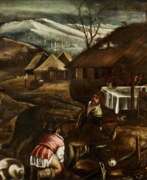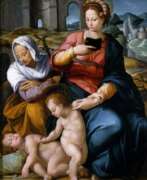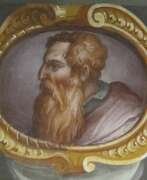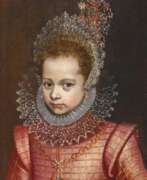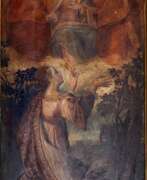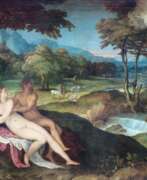High Renaissance 16th century


Mariotto Albertinelli, an Italian painter born in 1474, was a prominent figure in the High Renaissance, celebrated for his contribution to the Florentine school of painting. Albertinelli's work is distinguished by its adherence to the principles of the Renaissance, characterized by a profound appreciation for classical beauty, balanced compositions, and a deep engagement with religious themes.
Known for his collaboration with Fra Bartolommeo, Albertinelli's artistry was marked by a harmonious blend of spirituality and naturalism. His paintings are revered for their delicate handling of religious subjects, brought to life with vivid realism and emotional depth. This unique approach made him a pivotal figure in the evolution of Renaissance art, bridging the gap between the divine and the human.
Among his renowned works, the "Visitation of the Virgin Mary" stands out as a masterpiece, showcasing his skillful use of color and perspective to enhance the narrative. Albertinelli's contributions can be found in several prestigious museums and collections around the world, offering a testament to his enduring legacy.
For collectors and connoisseurs of art and antiques, Mariotto Albertinelli represents the quintessence of Renaissance artistry. His works not only capture the aesthetic ideals of his time but also reflect the cultural and spiritual aspirations of the era.
To delve deeper into the life and art of Mariotto Albertinelli and stay informed about upcoming exhibitions, sales, and auctions featuring his work, signing up for updates is essential. This subscription ensures that enthusiasts and collectors alike remain connected to the vibrant legacy of this Renaissance master, offering exclusive insights and opportunities to enhance their appreciation and collection.


Amico Aspertini was an Italian Renaissance painter, draughtsman, and sculptor, considered one of the leading representatives of the Bolognese school of painting.
He was trained in the family workshop and was influenced by the artists of the Ferrara school, Ercole de'Roberti, Lorenzo Costa, and Francesco Francia. He worked as a painter and sculptor, and was also an excellent draughtsman, as evidenced by his many surviving drawings and sketches. Contemporaries marveled at his complex and impulsive character and noted that he worked with both hands simultaneously.
Aspertini painted splendid portraits as well as numerous frescoes and altarpiece paintings in chapels and churches in Italy. Many of his works are eccentric and eclectic, even whimsically fantastical, his complex style anticipating Mannerism.


Francesco Xanto Avelli was an Italian ceramicist. He is best known for his painted maiolica works.
Xanto's signed works all date from between 1530 and 1542. Each bears his name and the date of the piece; many also were given ambitious tags explaining their meanings. The surviving pieces appear to be similar in nature, with the exception of the signatures, to most other maiolica ware produced in Urbino at the time. Xanto signed his works with a number of different variants of his own name; besides those with his full name, pieces signed fra Xanto in his hand are known to exist.
Besides being a ceramicist, Xanto was also a poet; in the 1530s he wrote a sequence of sonnets in praise of Francesco Maria I della Rovere, then duke of Urbino. An elegant fair copy survives in the Vatican Library.


Hans Baldung, also known as Hans Baldung Grien, was a prominent figure in the German Renaissance, celebrated for his innovative approach to painting, printmaking, and drawing. Born around 1484 in Schwäbisch Gmünd, Germany, and passing away in 1545 in Strasbourg, France, Baldung's career was marked by a distinctive style that art historians have associated with the mannerist tendencies of the time. His work is notable for its exploration of themes such as the imminence of death, the complexities of human sexuality, and scenes of witchcraft, distinguishing him from his contemporaries with a bold and unique artistic voice.
Educated in the workshop of Albrecht Dürer, Baldung quickly developed his own artistic language, absorbing and then transcending Dürer's influence. He is particularly renowned for his altarpieces, portraits, and a series of works that delve into eroticism and the supernatural. Among his most significant contributions is the high altar of the Freiburg Münster, an eleven-panel masterpiece depicting scenes from the life of the Virgin Mary, which remains a testament to his mastery over religious subjects even as he ventured into more secular and profane themes.
Baldung's fascination with witchcraft and his portrayal of witches in art were groundbreaking for the time. His works in this area, such as "The Witches' Sabbath" and "Weather Witches," reveal a complex interplay of humanist thought, classical literature, and contemporary beliefs about witchcraft. They offer a nuanced perspective that blends satire with a deeper commentary on human nature and societal fears, marking Baldung as a pioneer in the visual exploration of these themes.
Despite his engagement with the themes of death and witchcraft, Baldung's oeuvre is also rich in portraits characterized by sharp individualization and psychological depth, as well as altarpieces that convey a profound spiritual and theological insight. His ability to navigate between the realms of the divine and the earthly, the solemn and the profane, solidifies his position as a versatile and innovative artist of the Renaissance.
For collectors and experts in art and antiques, Hans Baldung's work offers a unique window into the confluence of Renaissance artistry, humanist thought, and the socio-religious dynamics of early 16th-century Europe. His paintings and prints not only adorn museums and galleries worldwide but also continue to inspire and provoke deep reflection on the human condition.
To stay informed about new discoveries, exhibitions, and auction events related to Hans Baldung's art, signing up for updates can provide enthusiasts and collectors with valuable insights into the enduring legacy of this remarkable artist. This subscription service is designed to alert subscribers to new product sales and auction events specifically related to Hans Baldung, ensuring that they remain at the forefront of developments in the field of Renaissance art and antiques.


Fra Bartolomeo was an Italian painter, a notable figure of the High Renaissance. Known for his religious artworks, Fra Bartolommeo's style was deeply influenced by his spiritual journey and association with the Dominican Order.
After receiving his early artistic training from Cosimo Rosselli, Bartolommeo's style initially exhibited influences from artists like Piero di Cosimo, Domenico Ghirlandaio, and Filippino Lippi. However, his encounter with Savonarola, a Dominican friar and reformer, in the late 1490s led to a significant spiritual transformation. This encounter influenced him to enter the Dominican monastery at San Domenico in Prato as a novice in 1500, and he temporarily renounced painting. It wasn't until 1504, when he resumed painting as the head of the monastery workshop, that his style saw a significant transformation.
In his works, Fra Bartolomeo beautifully integrated the styles of Leonardo da Vinci and Raphael, especially in his altarpieces, which are imbued with a sense of pietism reminiscent of Fra Angelico. His work is notable for the skilled massing of light and shade, richness in coloring, and delicate handling of drapery. The introduction and use of the lay-figure with joints in his compositions were innovations he is credited with. His masterpiece, St. Mark Evangelist, and the undraped figure of Saint Sebastian, are particularly noted for their expressive power.
Some of his notable works include "Vision of St. Bernard" (1507), "The Holy Family with John the Baptist," and "Virgin and Child with Saints." His art can be found in prestigious galleries, including the Pinacoteca Vaticana, Palazzo Pitti in Florence, and the National Gallery in London.
For art collectors and enthusiasts, Fra Bartolomeo's works represent a blend of spiritual depth and artistic innovation during the pinnacle of the Renaissance period. His legacy in religious art continues to inspire and captivate audiences worldwide.
To stay informed about exhibitions and sales featuring works of Fra Bartolomeo, sign up for updates to explore more about this master's contributions to Renaissance art.


Giovanni Pietro Birago was an Italian painter, illuminator, and engraver for the Sforza court.
He worked from 1470 to 1513 in Brescia, Venice, and Milan, was a leading Milanese illustrator and was favored by the ducal court.


Giulio Antonio Bonasone was an Italian painter and engraver born in Bologna. He possibly studied painting under Lorenzo Sabbatini, and painted a Purgatory for the church of San Stefano, but all his paintings have been lost. He is better known as an engraver and is believed to have trained with Marcantonio Raimondi. He worked mainly in Mantua, Rome and Venice and with great success, producing etchings and engravings after the old masters and his own designs.
He has been regarded an engraver with extraordinary skills in reproducing, as he could accurately convey the sources' compositions, colours, and essence. Moreover, he expressed his understanding about the controversies about religion and culture in his time through his prints. He is considered among the most important and productive engravers of the sixteenth century.


Carlo Cannovaro Caliari was an Italian artist of the Renaissance period. He is also known as Carletto. The youngest son of Paolo Veronese, Caliari was active mainly in Venice, where he worked and inherited the studio of his far more famous father, and later worked along with his brother Gabriele and his uncle, Benedetto.


Peter Candid was a Flemish painter, tapestry designer, draughtsman and sculptor.
Pieter Candide worked mainly in Italy and Germany. He was an artist at the court of the Medici in Florence and at the Bavarian court of Duke Wilhelm V and his successor Maximilian I in Munich.
His paintings range from historical paintings, portraits, mythological scenes and allegories. He created large altarpiece images as well as complex decorative designs.
Candide's style was characterised by a combination of Italian and Flemish influences, with a particular emphasis on detailed, realistic depictions of the human form.


Vittore Carpaccio, an illustrious Italian painter, was a master of narrative storytelling and vivid detail, flourishing in Venice between 1465 and 1526. His specialization in religious and historical scenes set him apart, with a particular knack for infusing life and emotion into every brushstroke. Carpaccio's work exemplifies the Venetian School's richness, noted for its deep colors and intricate details that capture the viewer's imagination.
Carpaccio is renowned for his ability to weave intricate narratives through his paintings, often depicting scenes from the lives of saints with both devotion and a keen eye for daily Venetian life. His works are celebrated for their meticulous attention to architectural and costume details, offering a window into the Renaissance period's social and cultural contexts.
Among his known masterpieces, the cycle of paintings dedicated to the legend of Saint Ursula in the Scuola di San Giorgio degli Schiavoni in Venice stands as a testament to his narrative prowess and technical skill. These works, alongside others housed in prestigious galleries worldwide, underscore Carpaccio's significant contribution to the art world, making him a subject of admiration among collectors and art historians alike.
For those fascinated by the splendor of the Renaissance and the beauty of Venetian artistry, Vittore Carpaccio's oeuvre offers a rich tapestry of historical and religious narratives brought to life through his exceptional talent. His legacy continues to inspire and captivate, embodying the essence of one of the most vibrant periods in art history.
To delve deeper into the world of Vittore Carpaccio and stay informed about upcoming sales, exhibitions, and auction events featuring his work, signing up for updates is your gateway to the exclusive circle of Renaissance art enthusiasts. This subscription is a commitment to keeping you at the forefront of new discoveries and opportunities to enrich your collection with pieces by this Venetian master.


Marco d'Oggiono was an Italian Renaissance painter and a chief pupil of Leonardo da Vinci, many of whose works he copied.
He was a hard-working artist, but his work has since been criticized by some for paintings are wanting in vivacity of feeling and purity of drawing, while, in his composition, it has been well said that "intensity of color does duty for intensity of sentiment". He copied Leonardo's Last Supper repeatedly, and one of his best copies is in the possession of the Royal Academy of Arts.


Giovanni da Bologna, also known as Jean de Boulogne (French), Giambologna (Italian), Fiammingo (Italian) and Jehan Boulongne (Flemish), was the last significant Italian Renaissance sculptor, with a large workshop producing large and small works in bronze and marble in a late Mannerist style.


Polidoro Caldara, usually known as Polidoro da Caravaggio was an Italian painter of the Mannerist period, "arguably the most gifted and certainly the least conventional of Raphael's pupils", who was best known for his now-vanished paintings on the facades of Roman houses.


Antonio da Correggio was a seminal figure in the Italian Renaissance, particularly renowned for his mastery in illusionistic fresco decoration. His works bridged the gap between the High Renaissance and the Baroque movement, influencing many subsequent artists in the Baroque and Rococo styles. Antonio da Correggio is celebrated for his dynamic compositions, innovative use of perspective, and the sensual nature of his paintings, which often depicted religious and mythological themes.
Antonio da Correggio's notable contributions include the frescoes in the dome of San Giovanni Evangelista and the Cathedral of Parma. His work, characterized by dramatic foreshortening and emotional intensity, represents a pioneering approach to dome decoration, creating an immersive experience for the viewer. The "Assumption of the Virgin" in Parma's Cathedral is particularly renowned for its dynamic composition and innovative perspective, offering a celestial vision filled with angels and figures in motion, heralding the artistic transitions towards the Baroque era.
Additionally, Antonio da Correggio's mythological series, such as "Jupiter and Io" and "Leda and the Swan," demonstrate his ability to blend sensuality with divine themes, presenting these narratives with a tender and intimate touch that was groundbreaking for his time.
For collectors and experts in art and antiques, Correggio's works epitomize the transition in art styles from the Renaissance to the Baroque, showcasing his unique ability to convey emotion and movement through his innovative techniques and compositions.
To delve deeper into the life and works of Antonio da Correggio, consider subscribing to updates from art institutions or platforms that specialize in Renaissance art, ensuring you stay informed about exhibitions, sales, and scholarly research related to this influential artist.


Jacopo da Pontormo, an Italian painter born in 1494, was a pivotal figure in the Mannerist movement, diverging from the High Renaissance's balanced compositions to explore more expressive and emotionally charged art. His work is celebrated for its unusual color palettes, elongated forms, and a unique approach to perspective, all of which contribute to the intensely emotional effect of his paintings.
Operating in Florence, Pontormo's art is distinguished by its vivid expressiveness and dramatic tension, characteristics that set him apart from his contemporaries. His ability to convey deep psychological complexity through his subjects has left a lasting impact on the history of art, making his works highly prized among collectors and scholars alike.
One of his most acclaimed works, the "Deposition from the Cross" in the Capponi Chapel in Florence, exemplifies his innovative approach to composition and color, marking a significant departure from traditional depictions of this biblical scene. This masterpiece, along with others like his portraits and religious paintings, can be found in some of the world's most prestigious museums and galleries.
For art collectors and enthusiasts, Jacopo da Pontormo represents the intriguing complexity of the Mannerist period, offering a window into the evolving artistic landscape of 16th-century Italy. His works not only challenge the viewer's expectations but also invite a deeper exploration of the emotional and spiritual dimensions of painting.
To stay abreast of the latest discoveries, exhibitions, and auctions related to Jacopo da Pontormo's art, we encourage you to sign up for updates. This subscription is your gateway to the refined world of Renaissance and Mannerist art, ensuring you're informed about opportunities to enrich your collection with works by this exceptional artist.
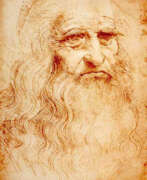

Leonardo da Vinci was an Italian polymath of the High Renaissance, celebrated as a painter, draughtsman, engineer, scientist, theorist, sculptor, and architect. His remarkable abilities and innovative thinking made him an epitome of the Renaissance humanist ideal. Born in Vinci, near Florence, in 1452, Leonardo was educated in Florence by Andrea del Verrocchio, a renowned painter and sculptor. He began his career in Florence, later working in Milan, Rome, and France, where he died in 1519.
Da Vinci is revered for his artistic mastery, technological innovation, and scientific inquiry. Despite having fewer than 25 major works attributed to him, including several unfinished ones, his influence on Western art is profound. His magnum opus, the "Mona Lisa," housed in the Louvre Museum, Paris, is considered the world's most famous painting. "The Last Supper," his most reproduced religious painting, showcases his mastery of dramatic narrative and pictorial illusionism. Both paintings exhibit Leonardo's unique ability to convey complex human emotions and his innovative use of techniques like sfumato and chiaroscuro.
Leonardo's interests extended far beyond fine art. He was a visionary in multiple fields, including anatomy, physics, architecture, and mechanics. His notebooks reveal designs for machines like bicycles, helicopters, and military tanks, centuries ahead of their time. However, due to his diverse interests, he left many projects and paintings incomplete. Leonardo's final years were spent in France, where he continued his artistic and scientific pursuits until his death.
For collectors and experts in art and antiques, Leonardo da Vinci remains a figure of endless fascination. His works not only embody the pinnacle of Renaissance art but also provide insights into the era's scientific and philosophical inquiry. To stay updated on new sales and auction events related to Leonardo da Vinci, sign up for our newsletter. This subscription is a gateway to exploring the rich legacy of this unparalleled artist and inventor.


Philippe de Gueldre was a French painter, illustrator, and miniaturist from the Netherlands.
He worked on a large number of royal commissions in Paris and northern France at the turn of the 15th and 16th centuries. Philippe's style was influenced by Jean Columbus; he was characterized by wide-boned figures with round faces, long noses, and small red mouths. He makes generous use of blue and gold, burgundy and green in his palette.


Attavante degli Attavanti, also Gabriello di Vante, is the best known and most representative artist of Italian miniature painting.
Attavante's elegant, expressive style was influenced by the work of Domenico Ghirlandaio and Antonio Pollaiuolo. His first recorded work, dated 1483, is a missal created for Thomas James, bishop of the Dol-de-Bretagne. He subsequently created several manuscripts for Matthias Corvinus, King of Hungary, and the Medici family, among whom was Pope Leo X. The workshop of Attavante also produced the Jerome Bible, one of the finest bibles created during the Italian Renaissance, now in the Portuguese National Archives.


Giovanni di Niccolò de Luteri, better known as Dosso Dossi, was an Italian Renaissance painter who belonged to the School of Ferrara, painting in a style mainly influenced by Venetian painting, in particular Giorgione and early Titian.
From 1514 to his death he was court artist to the Este Dukes of Ferrara and of Modena, whose small court valued its reputation as an artistic centre. He often worked with his younger brother Battista Dossi, who had worked under Raphael. He painted many mythological subjects and allegories with a rather dream-like atmospheres, and often striking disharmonies in colour. His portraits also often show rather unusual poses or expressions for works originating in a court.


Jan Gossaert was a French-speaking painter from the Low Countries also known as Jan Mabuse (the name he adopted from his birthplace, Maubeuge) or Jennyn van Hennegouwe (Hainaut), as he called himself when he matriculated in the Guild of Saint Luke, at Antwerp, in 1503. He was one of the first painters of Dutch and Flemish Renaissance painting to visit Italy and Rome, which he did in 1508–09, and a leader of the style known as Romanism, which brought elements of Italian Renaissance painting to the north, sometimes with a rather awkward effect. He achieved fame across at least northern Europe, and painted religious subjects, including large altarpieces, but also portraits and mythological subjects, including some nudity.


Lorenzo Lotto was an Italian painter whose work stands as a testament to the complexity and diversity of the Renaissance period. Born in Venice, Lotto is celebrated for his unique approach to portraiture and religious compositions, which diverged from the conventions of his time to reflect a deeply personal and psychological depth in his subjects.
Lotto's art is renowned for its vibrant color palette, intricate details, and the emotional intensity of his figures. Unlike many of his contemporaries, he ventured beyond mere representation to capture the inner turmoil and spirituality of his subjects, making his paintings captivatingly lifelike and relatable. This ability to evoke emotion and character set him apart in an era defined by great artistic achievements.
Among his most acclaimed works are his portraits, which are housed in some of the world's leading museums and galleries. These paintings are celebrated for their innovative use of light and shadow, as well as their subtle yet profound expressions of the human condition. Lotto's altarpieces and religious scenes are equally significant, marked by their narrative clarity and the sensitive portrayal of biblical figures.
For collectors and connoisseurs of Renaissance art, Lorenzo Lotto represents an intriguing figure whose works offer rich insights into the era's artistic and cultural landscapes. His paintings not only delight the eye but also engage the mind, inviting viewers to explore the deeper meanings behind his art.
To stay informed about the latest discoveries, exhibitions, and auctions featuring the works of Lorenzo Lotto, signing up for updates is crucial. This subscription ensures that you remain connected to the world of art collecting, providing exclusive opportunities to appreciate and acquire pieces by this remarkable Renaissance master.


Niccolò di Bernardo Machiavelli was an Italian philosopher, politician and diplomat, historian and Renaissance writer.
As a young man, Niccolò Machiavelli faced financial difficulties due to his father's debts, but had access to a rich library. Machiavelli's early life and career began during a period of political upheaval in Italy. After the expulsion of the Medici family in 1494, for 14 years Niccolo Machiavelli served as a diplomat to the Florentine Republic. During this service, he gained a reputation as a cunning and unconventional thinker. However, when the Medici returned to power in 1512, Machiavelli was dismissed, imprisoned, and temporarily removed from political life.
During this period Machiavelli wrote his famous work The Sovereign, which has become one of the key works in the history of political philosophy. This book epitomizes the Machiavellian approach to politics, where the means justify the end, and where a leader should use any method to consolidate his power. The treatise drew criticism from the Pope, who condemned it for supporting rule through deceit and fear. Nevertheless, The Sovereign is still an important work of political literature, and Machiavelli has come to be called "the father of modern political theory."
Machiavelli lived the rest of his life in a small village near Florence, where he continued his creative endeavors, writing On the Art of War, as well as poems and plays. His literary legacy has become an integral part of the history of political philosophy.


Vicente Juan Masip, also known as Joan de Joanes, was a Spanish painter, a member of the Valencian Renaissance painter dynasty.
He studied painting in Italy, imitating in his works the style of Raphael, and painted religious subjects as well as portraits.


Andrea Meldolla (Schiavone) was an Italian Renaissance painter and etcher, born in present-day Croatia, active mainly in the city of Venice. His style combined Mannerist elements, a relative rarity in Venice, with much influence from the mainstream of Venetian painting, especially Titian.


Parmigianino, an Italian Mannerist painter born Girolamo Francesco Maria Mazzola, was a pivotal figure in the development of the Mannerist style, known for his sophisticated and elegant approach to painting. He was a leading figure in Parma's art scene following Correggio and had a significant influence on the artistic developments during the post-High Renaissance period through his expressive and stylish works.
Parmigianino's journey as an artist took him from Parma to Rome and then to Bologna, with his last years spent in Parma. His works, including the renowned "Madonna with the Long Neck," display a unique blend of grace and elegance, coupled with an idiosyncratic use of elongation and distortion, typical of Mannerist aesthetics. This painting, in particular, is noted for its unusual composition and the elongation of figures, embodying the Mannerist style's departure from the proportional norms established during the Renaissance.
He was also an early Italian etcher, utilizing this technique to express the spontaneity of an artist's hand. His etchings and drawings had a considerable influence on printmaking and the visual arts in Italy and Europe. In addition to his paintings, Parmigianino's contributions to the arts include his work in the church of the Steccata in Parma and his innovative approach to integrating painting with architectural elements.
For art collectors and experts, Parmigianino's work represents a critical link between the High Renaissance and the emergence of Baroque and Rococo styles, offering a unique insight into the evolution of European art. His works continue to be celebrated for their originality and mastery, making him a subject of enduring interest in the study of art history.
For those interested in exploring Parmigianino's contributions to art further, subscribing to updates from art institutions or platforms specializing in Renaissance and Mannerist art could provide valuable insights into his life, works, and ongoing exhibitions or sales of his artworks.


Giovan Francesco Penni, an Italian painter born in 1488, carved a niche for himself amidst the luminaries of the Renaissance. As a native of Florence, his artistry was cradled in the birthplace of the Renaissance, allowing him to develop a specialization that beautifully married traditional techniques with the burgeoning innovations of the time.
Penni is best known for his intimate collaboration with Raphael, one of the era's most celebrated masters. This association not only honed his skills but also deeply influenced his artistic direction, imbuing his works with a blend of grace and narrative depth characteristic of the High Renaissance. Penni's contributions to art, though less documented than those of his contemporaries, highlight his adeptness in painting and his ability to capture the ethereal beauty of religious and mythological subjects.
His known works, which include contributions to the Raphael Rooms in the Vatican, stand as testament to his skill and artistic vision. While many of his individual pieces may reside in obscurity, those attributed to him and preserved in museums and galleries across Europe continue to enchant art lovers with their elegance and historical significance.
For collectors and experts in art and antiques, Giovan Francesco Penni represents an intriguing figure whose legacy is ripe for rediscovery. His works, woven into the tapestry of Renaissance art, offer a unique lens through which to explore an era that shaped the course of Western art history.
In pursuit of uncovering the treasures of Giovan Francesco Penni's oeuvre, we invite you to sign up for updates. This subscription will ensure you're informed about the latest findings, sales, and auction events related to Penni's work, offering exclusive opportunities to delve deeper into the rich legacy of this Renaissance artist.


Jean Pichore was a French painter, illustrator, and miniaturist.
He was one of the most famous and prolific illuminators in the production of horologers in Paris at the beginning of the 16th century. Between 1490 and 1521, he was head of a rather large workshop which carried out many orders, while he himself produced only selected works. Jean Pichore worked in many fields, including altarpiece painting, stained glass windows, tapestry designs and illuminated manuscripts.


Pinturicchio, real name Bernardino di Betto di Biagio, was an Italian Renaissance painter.
Pinturicchio was a representative of the Umbrian Quattrocento school. He studied with Fiorenzo di Lorenzo, and together with Raphael with Perugino, who helped him paint the frescoes in the Sistine Chapel at the Vatican (1481-1482). As a mature master, Pinturicchio rejected some of Perugino's principles - the monotony and gradualness of the figures, the unity of time and place - which brings him rather closer to Botticelli.
His best known murals are in the churches of Santa Maria del Popolo, Santa Maria in Araceli and the Borgia Apartments in Rome, and in Siena Cathedral (Piccolomini Library). The frescoes of this artist's works often feature 'grotesques'. Of the easel paintings, 'Portrait of a Boy' from the Old Masters Gallery in Dresden is noteworthy.


Giovanni Girolamo Savoldo was an Italian High Renaissance painter active mostly in Venice, although he also worked in other cities in northern Italy. He is noted for his subtle use of color and chiaroscuro, and for the sober realism of his works, which are mostly religious subjects, with a few portraits. His portraits are given interest by their accessories or settings; "some even look like extracts from larger narratives".
About 40 paintings by Savoldo are known in all, six of them portraits; only a handful of drawings by him are known. He was highly regarded in his own lifetime; several repetitions of works were commissioned from him, and copies of his work made by others. He slipped from general awareness, however, and many of his works were assigned to more famous artists, especially Giorgione, by the art trade. Awareness of his oeuvre revived in the 19th century, though the dating of many paintings remains controversial among specialists.


Hendrik van Cleve III was a Flemish painter, draughtsman and designer of prints. He is known for topographical views, including views of Rome and the Vatican, as well as imaginary landscapes. Traditionally, a large number of depictions of the construction of the Tower of Babel have been attributed to him but most of these are now attributed to anonymous Flemish painters, who are referred to as 'The Hendrik van Cleve III Group'.


Marinus van Reymerswaele was a Dutch Renaissance painter mainly known for his genre scenes and religious compositions. After studying in Leuven and training and working as an artist in Antwerp, he returned later to work in his native Northern Netherlands. He operated a large workshop which produced many versions of mainly four themes: the tax collectors, the money changer and his wife, the calling of Saint Matthew and St. Jerome in his study.


Jan van Scorel was a Dutch painter, who played a leading role in introducing aspects of Italian Renaissance painting into Dutch and Flemish Renaissance painting. He was one of the early painters of the Romanist style who had spent a number of years in Italy, where he thoroughly absorbed the Italian style of painting.


Tiziano Vecellio, an Italian Renaissance painter from Venice, stands out as a pivotal figure in the art world, renowned for his versatility across various genres like portraits, landscapes, and religious subjects. His influence on the development of Western art, particularly through his revolutionary use of color, is profound and long-lasting.
Born around 1488/90 in Pieve di Cadore, part of the then Republic of Venice, Titian's talent was evident early on. He began his artistic journey in the studio of the Bellini brothers in Venice, later joining forces with Giorgione, another influential painter of the time. This collaboration marked the beginning of a distinguished career that would see Titian become the most sought-after painter in Europe, working for nobility, the Habsburgs, and the papacy.
Titian's style evolved significantly throughout his career. He initially gained recognition for his vibrant, luminous colors and later became famous for his loose brushwork and subtle tonality. This shift was not just a matter of aesthetics but also represented a deeper understanding of color and light. Titian's approach to painting, particularly his use of colore, where he juxtaposed colors to define compositions, contrasted sharply with the line-focused disegno technique of the time. This method contributed significantly to the distinctiveness of Venetian art.
Among his many patrons, Emperor Charles V and his son, Philip II of Spain, were perhaps the most notable. As their official painter, Titian created numerous portraits and mythological works that were celebrated for their psychological depth and expressive use of color. His 'poesie' series for Philip II, including famous works like "Diana and Actaeon," showcased his skill in portraying mythological narratives with a sense of drama and sensuality.
Titian's later works, created in the 1560s and 1570s, are particularly revered for their experimental nature, pushing his art towards what has been termed 'magic impressionism'. These works, like "The Death of Actaeon" and the unfinished "Pietà", demonstrate a radical departure from his earlier style and reflect a continued evolution even in his later years.
For art collectors and experts, Titian's oeuvre represents a crucial link in the history of European art, illustrating the transition from the Renaissance to a more modern, expressive form of painting. His mastery of color and light, combined with his ability to convey deep emotional resonance, continues to influence artists and captivate viewers centuries later.
To stay updated on artworks and auction events related to Tiziano Vecelli, consider signing up for updates. This subscription will ensure you are informed about new product sales and auction events related to this remarkable artist.


